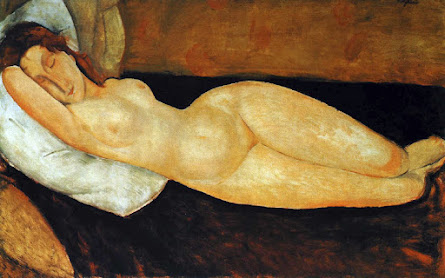Alfred de Musset is a French writer from the first half of the 19th century, also known as the romantic period in literature. Confession of a child of the century was published in 1836 and is a fictional novel which contains autobiographic elements. An important part of the narration is about a love story between Octave, the protagonist, and Brigitte – this romance is inspired by Musset’s relashionship with George Sand. In the first chapter of the fourth part we can read “She showed me how she had changed her coiffure which had displeased me, and told me how she had passed the day arranging her hair to suit my taste”, in less than a sentence is formulated the fondamental belief behind the male gaze : women are supposed to please men.
 Amedeo Modigliani is an Italian painter and sculptor born at the end of the 19th century. He is famous for his emblematic portraits and his multiple nude paintings of various women. These artworks illustrate the two main consequences of the male gaze : the sexualisation and the objectification of women. Firstly, the painter places the breasts or buttocks of the models in the center of the canvas with poses that emphasises these fantasized body parts. This sexualisation of women is also depicted in Musset’s novel in which females are either sensual mistresses or sweet wives. This binary and simplistic vision is sumed up by the narrator when he gives a relashionship advice to a friend “Two questions: Is she pretty? Do you love her? If you love her, forget her; if she is pretty and you do not love her, keep her for your pleasure; there will always be time to quit her, if it is merely a matter of beauty, and one is worth as much as another.” (part 4 chapter 1). Here, if a woman is not loved, she is reduced to her appearence and her sexual value. Moreover, we can note that this “type” of women is described as temporary and replaceable. For sure no reader is going to envy this position, however being the loved one is not necessarly more gratifying.
Amedeo Modigliani is an Italian painter and sculptor born at the end of the 19th century. He is famous for his emblematic portraits and his multiple nude paintings of various women. These artworks illustrate the two main consequences of the male gaze : the sexualisation and the objectification of women. Firstly, the painter places the breasts or buttocks of the models in the center of the canvas with poses that emphasises these fantasized body parts. This sexualisation of women is also depicted in Musset’s novel in which females are either sensual mistresses or sweet wives. This binary and simplistic vision is sumed up by the narrator when he gives a relashionship advice to a friend “Two questions: Is she pretty? Do you love her? If you love her, forget her; if she is pretty and you do not love her, keep her for your pleasure; there will always be time to quit her, if it is merely a matter of beauty, and one is worth as much as another.” (part 4 chapter 1). Here, if a woman is not loved, she is reduced to her appearence and her sexual value. Moreover, we can note that this “type” of women is described as temporary and replaceable. For sure no reader is going to envy this position, however being the loved one is not necessarly more gratifying.
Throughout these examples, my aim was to show that the male gaze is not reserved to cheesy american romcoms. The arts field has been dominated by men for a very long time and the image of women has been mutilated at the same time. I chose to talk about Musset and Modigliani because I personally love their artworks. I think it is essential to be aware of that misrepresentation of women in fiction, but it does not mean that those creations cannot be appreciated. Of course you can also dive in the work of contemporary artists who are working on reshaping feminine characters, making them more diverse and interesting.
Nina




Interesting read and love the artwork. I think it would be interesting to see how women artists depict their own gender and the opposite sex, to see if this "male gaze" truly is a characteristic of just men or if it's the way society as a whole looks at people. Looking back I can see several artists which stand-out in this regard, especially in the last century. Looking foward to reading more
RépondreSupprimerThat is actually a very good idea, thank you for sharing your thoughts about the post !
SupprimerThis enlightening post was indeed a step in the right direction Nina, thank you.
RépondreSupprimerThanks for your comment !
SupprimerThank you Nina for sharing your thoughts! The male gaze is something we do not talk about enough.
RépondreSupprimerFor sure! These topics tend to be perceived as too "militant" or "political" to be discussed during casual conversations, which is quite sad...
SupprimerAn innovative way to link two great artists such as Musset and Modigliani! Loved the nuanced picture you gave of the complex issue of male gaze :))
RépondreSupprimerThank you my dearest friend ;)
SupprimerVery interesting ! Thank you Nina for sharing your point of view on gender expectations in art and litterature. It gives me food for thought ;-)
RépondreSupprimerIt's probably a good addition to your recent readings ;)
Supprimer